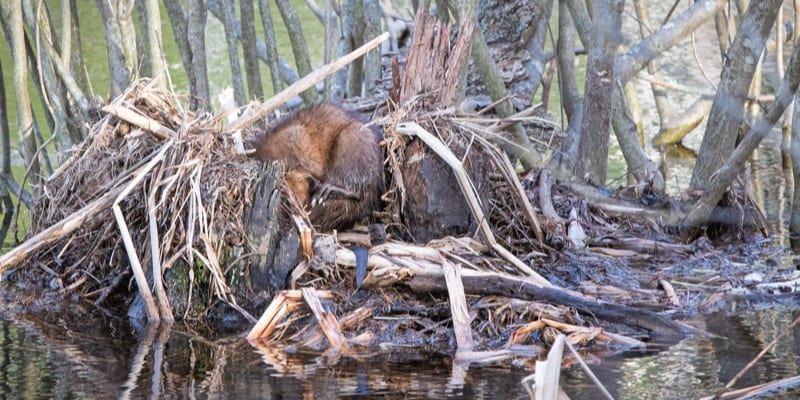 Wildlife like the muskrats Middleton Stream Team founding member Pike Messenger describes in the Water Closet article, are just some of the “people” who need reliable water to survive. You can protect our rivers, streams, and muskrats by taking the Water for People pledge here.
Wildlife like the muskrats Middleton Stream Team founding member Pike Messenger describes in the Water Closet article, are just some of the “people” who need reliable water to survive. You can protect our rivers, streams, and muskrats by taking the Water for People pledge here.
Three quarters of a century ago several lads I knew trapped muskrats. They sold their pelts to furriers for fancy coats. Now and then they’d catch a mink that might end up in a celebrity’s or gun moll’s more expensive wrapping. The trapper folks I knew all wore woolen coats in those days. We boys had winter coats called mackinaws. In 1997 The Great and General Court of Massachusetts banned the use of cruel, steel leg-hold traps underwater, and because trapping with other devices was expensive and less efficient, such trapping stopped. Also, animal fur for show had gone out of fashion.
I agreed with the state’s ban, yet as a lad I admired my spunky friends who daily ran their traplines, often in freezing weather. They got a dollar or two per pelt, what I earned for a day on the farm. Multiply this by 20 to bring the value of the dollar up to date. They were getting the present equivalent of $20 a pelt. For a mink they made several times that. Beavers weren’t around here then. They didn’t return with their once much sought-after coats until steel traps were banned here. Had the muskrat victims had a band maybe they’d have celebrated with an old song called “Muskrat Ramble,” which Louis Armstrong famously trumpeted and sang. It starts out:
I look at them shuffle and the shuffle come down
Rambling and scrambling and a-headin’ for town
Well this year we’ve got what may be several muskrat towns here in Middleton. I won’t tell you where because you old trappers may find your rusty traps and become scofflaws. We hikers often visit the wide floodplains along our brooks and rivers to see muskrats swimming. The water is high year-round now due to beaver dams. Maybe muskrats do some “rambling and scrambling” underwater. On the surface they swim gracefully and swiftly, wagging their vertically flattened, narrow tails side to side. This is one way you can tell them from beavers whose wide, flat tails move up and down under water not breaking the surface unless slapping for the noise. They are similar rodents in many ways, but beavers are much heavier. The average adult muskrat weighs two to four pounds, beavers 30 to 55. Both make lodges. We are seeing many more muskrat lodges this spring and summer than in recent years. Muskrat lodges are of mud and soft plants up to three feet high, five feet in diameter. The larger ones may house several to a dozen muskrats. Their houses have a couple access holes in the bottom opening to the water. Beaver lodges of sticks and mud are much larger and stronger. The smaller, softer lodges of muskrats are often swept away by high, fast spring flows.

Spotting wildlife, like the muskrat grooming itself above, it one of the many joys of exploring the Ipswich River! Explore the Ipswich River Water Trail on your own or join us for a Virtual Paddle.
Muskrat parents have two to three litters a year with up to six young per litter. Beavers have one litter with two to three offspring per year. These aquatic rodents’ habitats are very similar. Muskrats don’t make dams but they often thrive where beavers have. Relatively small Middleton has fifty or so beaver dams. I’ve been keeping a map of their lodges and dams since their return in the late 1990s after a hiatus of over three centuries. I mention this about beavers because the smaller aquatic mammal’s habitats are intertwined. Ironically, their best adaptations are what made them sought after by man for ostentatious hats and coats. Both have dense waterproof inner coats, fur once much prized by man. * And to be prized by man does not bear well for animals. I am reminded of the poor whales of the world hunted down to the ends of the oceans for their oil-bearing blubber and meat. * Then there were the buffalo wiped out often for fun by so called “sportsmen.” Shore birds and passenger pigeons were slaughtered by the billions, by market hunters; cod and eels by the fishing industry followed suit. The list goes on. Our relationships with too many of our fellow creatures have been similar ones, still are in too many places. It cheers us on our visits this year to see muskrats and beavers left alone by us and doing well, and making evermore watery habitats for plants and other animals.
The town of Middleton in 2019 bought over 50 acres of land where folks until 2018 played golf. Muskrats weren’t part of the town fathers and mothers’ goal; however, with the land they acquired five manmade ponds that are rich muskrat habitat near the center of town. These ponds t drain westerly to a large red maple swamp, the floodplain of little known Punchards Brook which flows southeasterly to the Ipswich River. Even in the golfing days the open land was frequented by foxes, otters, hawks, coyotes, fisher, great blue herons, and other predators seeking muskrats, fish and smaller prey. I haven’t heard of any trappers there since 1967 when the ponds were made.
Muskrats also build bank homes, six to eight-inch diameter tunnels in pond and stream banks. Reports have them making networks hundreds of feet long with periodic living rooms for several muskrat families. At the golf course I’ve only seen these so-called bank homes. Visit and sit quietly on the downwind side of the ponds or streams and wait. Muskrats having poor eyesight and hearing, have good senses of smell. The other day one swimming in Boston Brook came out on the stream bank 12 feet from me. I was downwind, and statue still. It scratched quite like a dog for a couple minutes, then reentered the water and continued on northeast swimming on the surface. Often, you’ll see one with several long cattail leaves trailing along each side of its mouth. Upon coming to its underwater entrance, it dives and leaves us wondering what happens next. And with that dear reader I’ll leave you to your own research of our fellow mammals who may outnumber us in our suburban towns. They certainly have a higher birthrate. They do have predators, but no longer the worse.
Here are some favorite references of mine on mammals.
Donald and Lillian Stokes, Animal Tracking and Behavior – muskrats p. 247 – 255
Paul Rezendes, Tracking and the Art to Seeing – muskrats p. 77 – 84
* Dolin, Eric Jay – Fur Fortune, and Empire: The Epic History of the Fur Trade in America
* Dolin, Eric Jay – Leviathan: The History of Whaling in America
*Fur, Fortune and Empire by Eric Dolan
*Leviathan: The History of American Whaling by Eric Dolan
